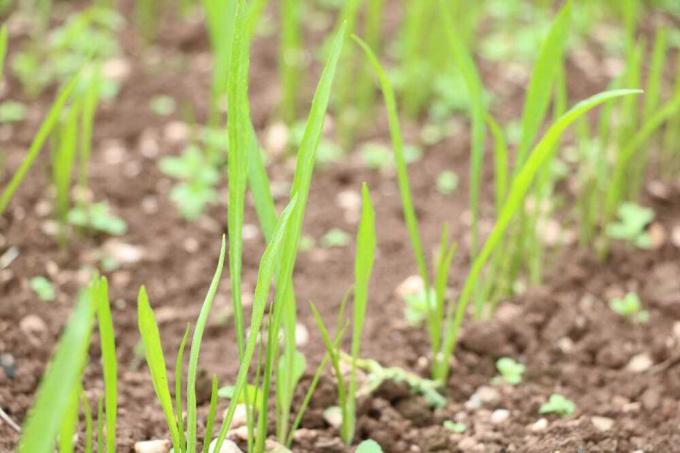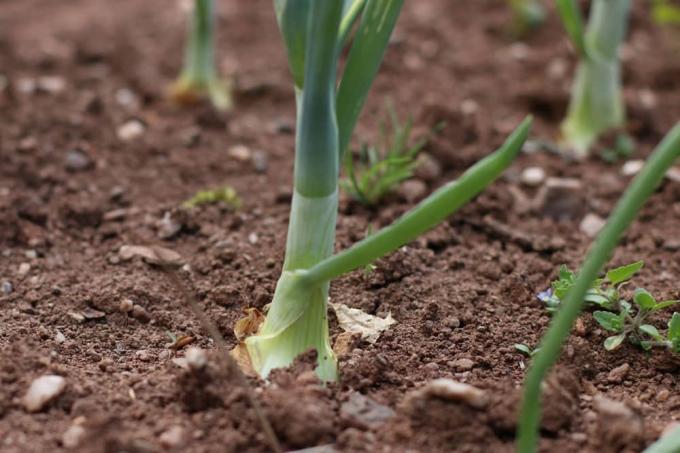

Table of contents
- Location
- substrate
- seed
- pre-breeding and sowing
- Water
- Fertilize
- harvest
- storage
- Pests, diseases and care errors
- Conclusion
According to the German Society for Nutrition, black salsify is rich in minerals and low in calories. This makes it a healthy vegetable and can enrich the diet, especially in winter. If you want to enjoy them particularly fresh, you don't need a lot of space or a green thumb - because the plants are hardy and easy to care for. Only at the beginning of the cultivation of the garden black salsify must one pay close attention to a few conditions.
Location
The location for the black salsify should be sunny to semi-shady. If the groundwater is very high, the soil is very wet or the climate is cold, cultivation on one is also recommended mound or in a raised bed to encourage water drainage and crop harvesting even in frosty weather facilitate.
substrate
The optimal soil for growing the garden black salsify is:
- Loose and not tending towards compaction
- Moist but not wet
- Free from stones
- Deeply relaxed
- humor
Good quality garden soil or potting soil with mature compost to increase the nutrient content and sand to loosen is ideal. In addition, the soil should be dug up or loosened at least 20 to 30 centimeters deep before sowing.
seed

When selecting the seeds, care should be taken that they are not older than one year. The ability to germinate decreases rapidly over time. In addition, the seeds of black salsify quickly become brittle due to their stem shape and consistency. They must therefore be treated with appropriate care. If the seeds are to be obtained yourself, the following procedure is important:
- After harvesting, some salsify is left in the ground.
- After the formation of the fragrant flowers, around June or July, the inflorescences mature and dry. In this state they are reminiscent of the seeds of the dandelion.
- As soon as the umbrellas open in the middle of the flower, the entire seed heads are removed and stored in a dry place. It is important to collect the seeds as early as possible, otherwise they will spread themselves around the area.
pre-breeding and sowing
Preparing the black salsify seeds is not recommended, as the seedlings are just as sensitive as the seeds and do not tolerate transplanting easily.
Sowing should therefore take place directly outdoors, between February and March. In regions with a very cold climate, it can also take place as late as April. However, the development of the roots is usually favored by early sowing.
The procedure for this is as follows:
- As mentioned, the earth is deeply loosened and stones are removed. In preparation, mature compost and, if necessary, sand are also mixed in.
- The seeds are used individually at a depth of two centimetres. A distance of six to ten centimeters is sufficient between the seeds. The distance between the rows should be between 20 and 30 centimeters.
- If the soil is dry, it is then poured with a flooding effect. Watering is then seldom done to prevent the seedlings from drying out.
Water
In order for salsify to develop as long and as straight as possible, it should rarely be poured overflowing. This also moistens the deeper layers of the earth and the roots grow towards the deeper water reserves. Regular watering is only necessary during longer dry periods. Then, however, it is sufficient to water it abundantly once a week.
Fertilize
If the soil was prepared with compost before sowing, the next fertilization can wait until late spring or early summer. The additional nutrient supply is then in turn provided by compost, which is applied around the plants and gently worked into the top layer of soil. Fertilizing once a month from May or June is usually sufficient.
harvest
The frost-hardy black salsify can be harvested from around October if sowed in good time. A clear sign of harvest maturity is the withering of the leaves. However, the garden black salsify does not have to be harvested immediately. Instead, action can be taken as needed. In this way it is possible to gradually harvest the roots over the winter and into the spring. The roots are each pricked out and dug out individually with a spade. It is important to get as deep into the ground as possible. A single black salsify reaches a length of about 35 centimeters. The excavation must be correspondingly deep.

Tip:
Here, too, the garden black salsify cultivation in mounds has proven its worth, because with this the harvest is very easy even in frost and the roots can be harvested without much effort.
storage
In winter, there are not always frost-free days when the salsify from your own cultivation can be harvested without any problems. It can therefore make sense to harvest for several meals in advance. This is also quite possible with the salsify. For this purpose, the earth is only roughly scraped off and the vegetables are placed or stuck in sand. Stored in this way in a cool place like the basement, the roots can last up to three weeks. If the winter vegetables have already been washed, they should be wrapped in newspaper and stored in the refrigerator. However, the shelf life is only up to three days. As an alternative, the harvested black salsify from your own garden can be cooked or boiled down.
Pests, diseases and care errors
Pests and diseases do not have to be expected with salsify. Especially during the harvest season, the risk of germs and parasites is extremely low. Mistakes in maintenance, on the other hand, can certainly occur. This is:
- Substrate that tends to compact
- Stones that impede straight growth
- wet floor
- Too loose soil
- Missing nutrients
- Wrong watering
- Poor planting order
If all factors have been checked and there are no abnormalities, the order of cultivation should be taken into account. Potatoes, lupins and related plants are ideal predecessors. They ensure good fertilization of the soil. Maize, cabbage and similar plants, on the other hand, are unfavorable predecessors and plant neighbors. They can ensure that the black salsify splits, is "deflected" in the direction of growth and remains very thin. This not only reduces the yield, but also makes harvesting and cleaning the winter vegetables more difficult.
Tip:
When cleaning the black salsify, the skin should be protected from the juice. Because this is extremely sticky and also strongly staining.
Conclusion
If some factors are taken into account when preparing the garden salsify cultivation, that is Winter vegetables are extremely easy to care for and require very little apart from a little patience Expense. The root vegetable, which is rich in minerals, rewards this with an as-needed harvest from autumn to spring and a low susceptibility to diseases and pests. Even beginners in gardening can therefore dare to grow the garden black salsify.
 garden editorial
garden editorial I write about everything that interests me in my garden.
Learn more about types of vegetables

Planting asparagus: 9 tips for growing asparagus
Asparagus can be grown in the garden or raised bed with a little knowledge of growth. In addition to the right choice of location, the preparatory and maintenance measures are of great importance. If you want to grow white or green asparagus, the procedure is slightly different.

Can you eat beetroot raw!? Healthy or dangerous?
Beets are tasty and healthy. As a rule, however, they will only be eaten cooked. But could you eat them raw? Yes, you could, beetroots are not poisonous. However, there are some disadvantages associated with it. More about this here.

Grow Peanut Plant | 10 tips for growing peanuts yourself
Peanuts are a popular snack. Whether in muesli, as a small snack between meals or as an ingredient in hearty dishes. They are tasty and, if consumed in moderation, bring health benefits. How good that you can draw them yourself.

Old Fruits & Vegetables | 26 historical & forgotten varieties
Among the historical varieties there are vegetables and fruits with an incomparable variety of tastes. Nevertheless, numerous varieties have disappeared or been forgotten. Lovers of old varieties make it possible for the precious treasures to be brought back into the focus of self-sufficient gardens.

Growing onions, sweet onions - sowing, planting and care
Onions can be cultivated in three different ways: you can plant onions, bring onions outdoors as direct sowing, and onions can be brought forward and then planted or cultivated. put. More and more people are now planting their own bulbs in the garden. For beginners, this may all sound a bit complicated. It's not difficult though. Practice makes perfect and the great sense of achievement comes at the latest with the harvest.

Growing radishes: sowing the plants, caring for them, harvesting + storing
Crunchy radishes taste deliciously aromatic with a touch of spiciness. You can easily grow the tubers yourself, in the garden or on the balcony. Here you will find everything you need to know and tips for cultivation. The harvest will be a complete success.
